31 Year NEET Previous Year Questions: Ray Optics & Optical Instruments - 1 - NEET MCQ
30 Questions MCQ Test Physics Class 12 - 31 Year NEET Previous Year Questions: Ray Optics & Optical Instruments - 1
A light ray falls on a rectangular glass slab as shown. The index of refraction of the glass, if total internal reflection is to occur at the vertical face, is [2002]


A body is located on a wall. Its image of equal size is to be obtained on a parallel wall with the help of a convex lens. The lens is placed at a distance 'd' ahead of second wall, then the required focal length will be [2002]
| 1 Crore+ students have signed up on EduRev. Have you? Download the App |
An equiconvex lens is cut into two halves along (i) XOX' and (ii) YOY' as shown in the figure. Let f, f ', f '' be the focal lengths of the complete lens, of each half in case (i), and of each half in case (ii), respectively. [2003]
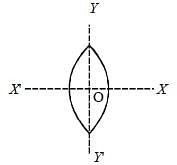
Choose the correct statement from the following

A convex lens is dipped in a liquid whoserefractive index is equal to the refractive index ofthe lens. Then its focal length will [2003]
The refractive index of the material of a prism is√2 and its refracting angle is 30º. One of therefracting surfaces of the prism is made a mirrorinwards. A beam of monochromatic light entersthe prism from the mirrored surface, then its angleof incidence of the prism is [2004]
A beam of light composed of red and green raysis incident obliquely at a point on the face ofrectangular glass slab. When coming out onthe opposite parallel face, the red and green raysemerge from [2004]
A telescope has an objective lens of 10 cmdiameter and is situated at a distance of onekilometer from two objects. The minimumdistance between these two objects, which canbe resolved by the telescope, when the meanwavelength of light is 5000 Å, is of the order of [2004]
The angular resolution of a 10 cm diametertelescope at a wavelength of 5000 Å is of theorder of [2005]
A convex lens and a concave lens, each havingsame focal length of 25 cm, are put in contact toform a combination of lenses. The power indiopters of the combination is [2006]
A microscope is focussed on a mark on a pieceof paper and then a slab of glass of thickness 3cm and refractive index 1.5 is placed over themark. How should the microscope be moved toget the mark in focus again ? [2006]
The frequency of a light wave in a material is2 × 1014 Hz and wavelength is 5000 Å. Therefractive index of material will be [2007]
A small coin is resting on the bottom of a beaker filled with liquid. A ray of light from the coin travels upto the surface of the liquid and moves along its surface. How fast is the light travelling in the liquid? [2007]

Two thin lenses of focal lengths f1 and f2 are in contact and coaxial. The power of the combination is: [2008]
A boy is trying to start a fire by focusing sunlighton a piece of paper using an equiconvex lens offocal length 10 cm. The diameter of the Sun is 1.39 ×109 m and its mean distance from the earthis 1.5 × 1011 m. What is the diameter of the Sun’simage on the paper? [2008]
A ray of light travelling in a transparent mediumof refractive index μ , falls on a surface separatingthe medium from air at an angle of incidence of450 . For which of the following value of μ theray can undergo total internal reflection? [2010]
Which of the following is not due to total internalreflection? [2011]
A biconvex lens has a radius of curvature ofmagnitude 20 cm. Which one of the followingoptions best describe the image formed of anobject of height 2 cm placed 30 cm from the lens? [2011]
A thin prism of angle 15º made of glass ofrefractive index μ1 = 1.5 is combined with anotherprism of glass of refractive index μ2 = 1.75. Thecombination of the prism produces dispersionwithout deviation. The angle of the second prismshould be [2011M]
A converging beam of rays is incident on adiverging lens. Having passed through the lensthe rays intersect at a point 15 cm from the lenson the opposite side. If the lens is removedthe point where the rays meet will move 5 cmcloser to the lens. The focal length of the lensis [2011M]
When a biconvex lens of glass having refractiveindex 1.47 is dipped in a liquid, it acts as a planesheet of glass. This implies that the liquid musthave refractive index. [2012]
A ray of light is incident at an angle of incidence, i, on one face of prism of angle A (assumed to be small) and emerges normally from the opposite face. If the refractive index of the prism is μ, the angle of incidence i, is nearly equal to: [2012]
f1’ is placed ata distance of 'd’ from a convex lens of focal length ‘f2’. A beam of light coming from infinity andfalling on this convex lens-concave mirrorcombination returns to infinity. The distance ‘d’ must equal : [2012]
The magnifying power of a telescope is 9. Whenit is adjusted for parallel rays the distancebetween the objective and eyepiece is 20 cm.The focal length of lenses are : [2012]
For the angle of minimum deviation of a prism tobe equal to its refracting angle, the prism mustbe made of a material whose refractive index : [2012M]
A rod of length 10 cm lies along the principalaxis of a concave mirror of focal length 10 cm insuch a way that its end closer to the pole is20 cm away from the mirror. The length of theimage is : [2012M]
The condition under which a microwave ovenheats up a food item containing water moleculesmost efficiently is [NEET 2013]
A plano convex lens fits exactly into a plano concave lens. Their plane surfaces are parallel to each other. If lenses are made of different materials of refractive indices μ1 and μ2 and R is the radius of curvature of the curved surface of the lenses, then the focal length of the combination is [NEET 2013]
For a normal eye, the cornea of eye provides aconverging power of 40D and the leastconverging power of the eye lens behind thecornea is 20D. Using this information, thedistance between the retina and the eye lens ofthe eye can be estimated to be [NEET 2013]
Two plane mirrors are inclined at 70°. A rayincident on one mirror at angle θ after reflectionfalls on second mirror and is reflected from thereparallel to first mirror. The value of θ is[NEET Kar. 2013]
The reddish appearance of the sun at sunriseand sunset is due to [NEET Kar. 2013]
|
98 videos|387 docs|104 tests
|





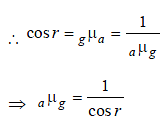





































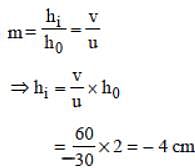










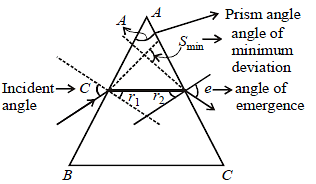












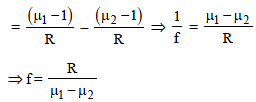


 Hence the light reaches us is rich in
Hence the light reaches us is rich in









